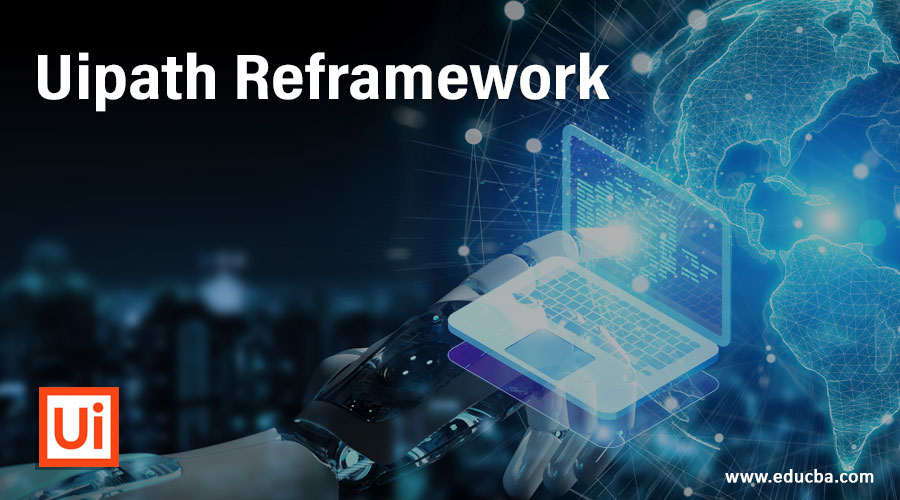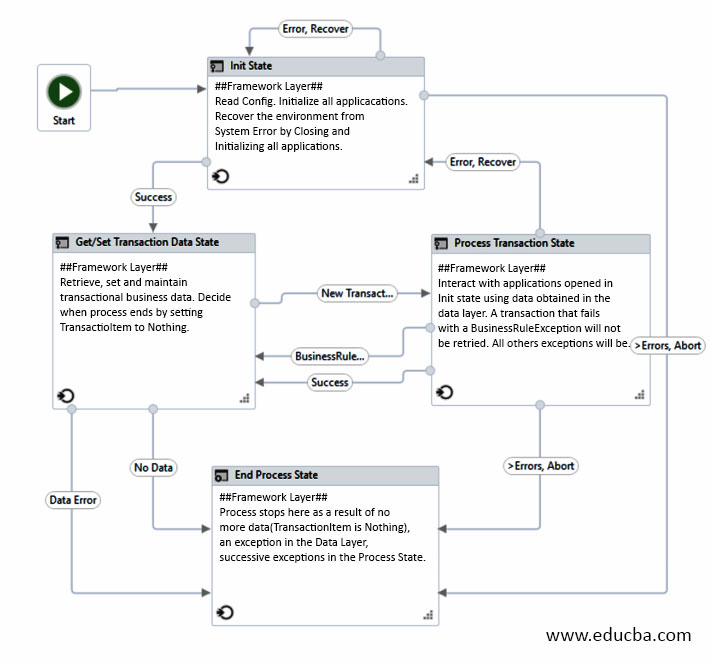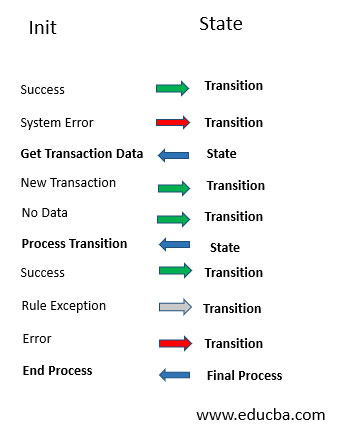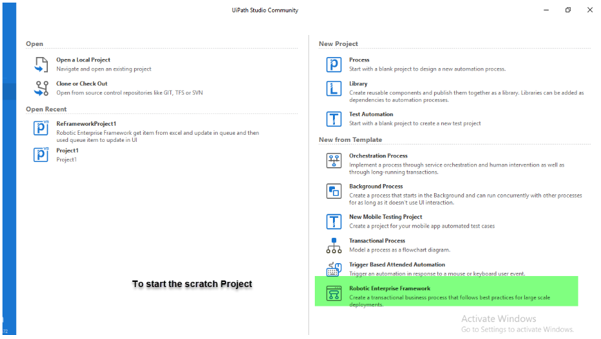Updated May 27, 2023

Introduction to Uipath Reframework
Uipath Reframework helps developers to build processes Quicker and more robustly and apply the best practices. It has many features: proper Exception Handling, Recovery abilities, Effective logging, Reusability, etc. In this topic, we are going to learn about Uipath Reframework.
Why use UiPath Re-Framework?
Re-Framework makes the developer’s tasks much easier. It can re-try the failed transactions and has the features to re-initialize the applications and handle the Exceptions accordingly without human intervention.
Re-Framework Architecture

In Re-Framework, every project has “Main .Xaml file” which uses the State machine workflow. It is prepared with 3 state activities, 1 final state Activity, and 7 Transitions. Each state has been connected with transitions.
We have 4 stages in Re-Framework.

1. Init
Init is the first state that is used to initialize the required apps and all settings by reading and storing the configuration data in a dictionary, killing unnecessary applications, and opening necessary applications.
The finest part of Re-Framework is that it has the form so that you can prepare the required applications in Init State.
2. Get Transaction Data State
Get Transaction data. The state is the data extraction method right after the Init state. It fetches the transaction item from Queue, Database, Data Table, Folder, etc.
Re-Framework has pre-defined components which look for stop requests. However, BOT will end the process if there are any transaction items in the Queue. This helps in analyzing the flow and if the user has identified any exception while BOT is processing and the user wants to end the process before it works wrong for other transactions.
If the state has new transaction item data, it goes to the next state to process the Transaction.
If there are no new items, then it goes to the End Process.
3. Process Transaction
The system uses it to process transactions retrieved from the previous state, called “Transaction Data State.”
If a transaction succeeds, the next transaction data is added to the Queue, and the loop is executed. When a certain action is performed, the Business Rule is triggered, causing the execution state to revert to the prior state.
Re-Framework has the prebuilt Set Transaction Status workflow, which sets the transaction status as either Success or Failure for each Item.
4. End State Process
Once all transactions have been successfully completed, the Robot enters the End state phase, closes all applications, terminates the applications, and ends the process.
You can see the below screen once you open the UiPath studio.

Examples of UiPath Re-Framework
Re-Framework is the best solution method to use when the user wants to upload multiple documents to a particular website, onboarding or offboarding the user in a company, scrape the data from hundreds of pages with less time, validate the applications, process the applications, validating and processing the Invoices, clearing the constant errors in the process.
Example #1 – Validating and processing the multiple Invoices
If you want to validate and upload multiple invoices in a particular web application, which are in the format of PDF, Word, and other formats.
Please follow the below steps:
- Add all the required application credentials in Config File.
- Add the required applications URL’s in Config File, which is an easier way than changing the details in the workflow design.
- Store the Invoice forms in particular folders as per the format.
- Validate the invoice forms based on the keywords and upload them in Web Application.
- Re-try if Bot has failed to validate or upload the Invoice file.
Example #2 – Employee/User -On-Boarding/Off Boarding Process
In many companies, It is very difficult to update the User details manually, filling forms when a new employee joins. Employee On-boarding details can be processed very easily within less time using Re-Frame work even though the company is relay on the Legacy system.
Examples #3 – Generating the reports for any network Issue
It is always difficult for humans to check manually when those servers’ utilization exceeds the threshold, as the checking process involves multiple steps.
In this case, BOT can easily log in to a particular server and check which process’s utilization is more, get exact values, and generate the ticket accordingly as per the steps given in the workflow.
Recommended Articles
This is a guide to Uipath Reframework. Here we discuss why to use UiPath Re-Framework and Re-Framework architecture along with the examples. You may also have a look at the following articles to learn more –

